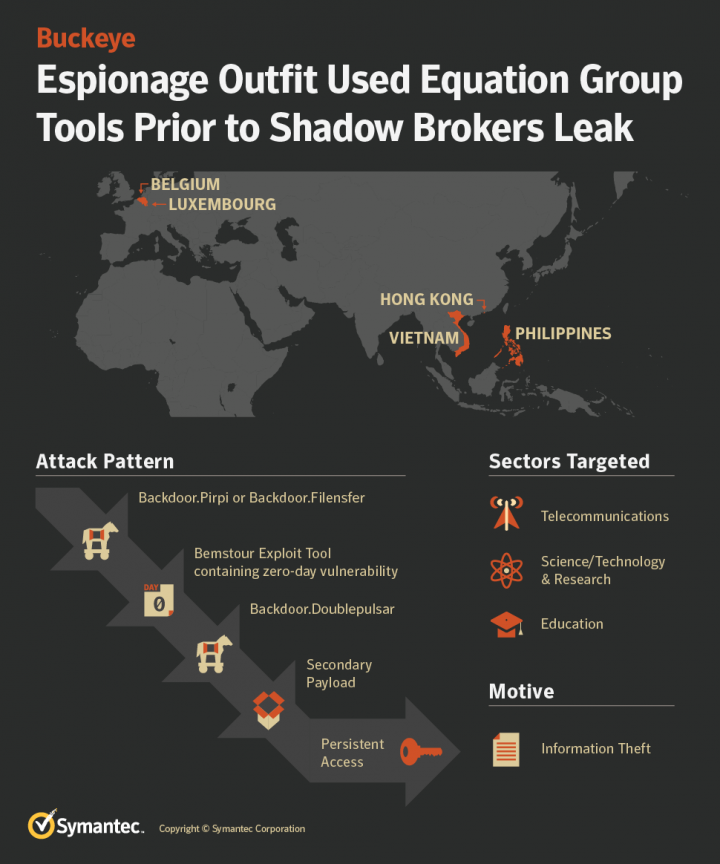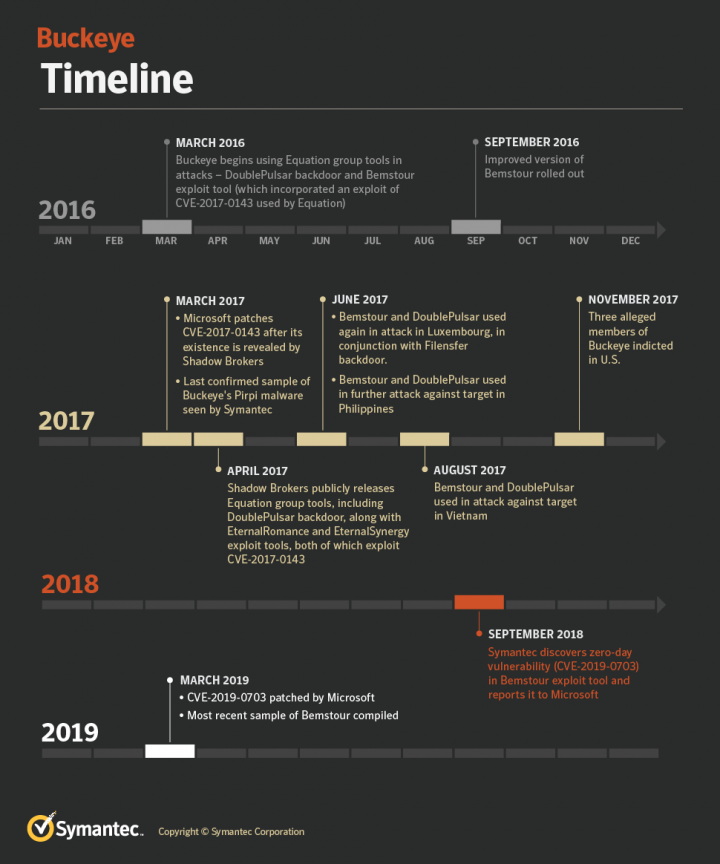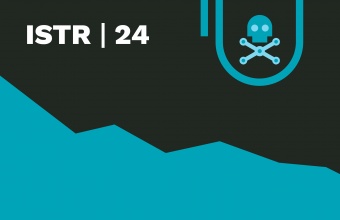Buckeye: Espionage Outfit Used Equation Group Tools Prior to Shadow Brokers Leak
Windows zero day was exploited by Buckeye alongside Equation Group tools during 2016 attacks. Exploit and tools continued to be used after Buckeye's apparent disappearance in 2017.
Key Findings
- The Buckeye attack group was using Equation Group tools to gain persistent access to target organizations at least a year prior to the Shadow Brokers leak.
- Variants of Equation Group tools used by Buckeye appear to be different from those released by Shadow Brokers, potentially indicating that they didn't originate from that leak.
- Buckeye's use of Equation Group tools also involved the exploit of a previously unknown Windows zero-day vulnerability. This zero day was reported by Symantec to Microsoft in September 2018 and patched in March 2019.
- While Buckeye appeared to cease operations in mid-2017, the Equation Group tools it used continued to be used in attacks until late 2018. It is unknown who continued to use the tools. They may have been passed to another group or Buckeye may have continued operating longer than supposed.
The 2017 leak of Equation Group tools by a mysterious group calling itself the Shadow Brokers was one of the most significant cyber security stories in recent years. Equation is regarded as one of the most technically adept espionage groups and the release of a trove of its tools had a major impact, with many attackers rushing to deploy the malware and exploits disclosed. One of these tools, the EternalBlue exploit, was used to devastating effect in the May 2017 WannaCry ransomware outbreak.
However, Symantec has now found evidence that the Buckeye cyber espionage group (aka APT3, Gothic Panda) began using Equation Group tools in attacks at least a year prior to the Shadow Brokers leak.
Beginning in March 2016, Buckeye began using a variant of DoublePulsar (Backdoor.Doublepulsar), a backdoor that was subsequently released by the Shadow Brokers in 2017. DoublePulsar was delivered to victims using a custom exploit tool (Trojan.Bemstour) that was specifically designed to install DoublePulsar.
Bemstour exploits two Windows vulnerabilities in order to achieve remote kernel code execution on targeted computers. One vulnerability is a Windows zero-day vulnerability (CVE-2019-0703) discovered by Symantec. The second Windows vulnerability (CVE-2017-0143) was patched in March 2017 after it was discovered to have been used by two exploit tools—EternalRomance and EternalSynergy—that were also released as part of the Shadow Brokers leak.
The zero-day vulnerability allows for the leaking of information and can be exploited in conjunction with other vulnerabilities to attain remote kernel code execution. It was reported by Symantec to Microsoft in September 2018 and was patched on March 12, 2019.
How Buckeye obtained Equation Group tools at least a year prior to the Shadow Brokers leak remains unknown.
Buckeye disappeared in mid-2017 and three alleged members of the group were indicted in the U.S. in November 2017. However, while activity involving known Buckeye tools ceased in mid-2017, the Bemstour exploit tool and the DoublePulsar variant used by Buckeye continued to be used until at least September 2018 in conjunction with different malware.

History of attacks
The Buckeye attack group had been active since at least 2009, when it began mounting a string of espionage attacks, mainly against organizations based in the U.S.
The group has a record of exploiting zero-day vulnerabilities. These include CVE-2010-3962 as part of an attack campaign in 2010 and CVE-2014-1776 in 2014. Although other zero-day attacks have been reported, they have not been confirmed by Symantec. All zero-day exploits known, or suspected, to have been used by this group are for vulnerabilities in Internet Explorer and Flash.
Timeline of attacks
Beginning in August 2016, a group calling itself the Shadow Brokers began releasing tools it claimed to have originated from the Equation Group. It initially released samples of the information it had, offering the full trove to the highest bidder. Over the coming months, it progressively released more tools, until April 2017, when it released a final, large cache of tools, including the DoublePulsar backdoor, the FuzzBunch framework, and the EternalBlue, EternalSynergy, and EternalRomance exploit tools.
However, Buckeye had already been using some of these leaked tools at least a year beforehand. The earliest known use of Equation Group tools by Buckeye is March 31, 2016, during an attack on a target in Hong Kong. During this attack, the Bemstour exploit tool was delivered to victims via known Buckeye malware (Backdoor.Pirpi). One hour later, Bemstour was used against an educational institution in Belgium.
Bemstour is specifically designed to deliver a variant of the DoublePulsar backdoor. DoublePulsar is then used to inject a secondary payload, which runs in memory only. The secondary payload enables the attackers to access the affected computer even after DoublePulsar is removed. It is worth noting that earlier versions did not include any means of uninstalling the DoublePulsar implant. This functionality was added in later versions.
A significantly improved variant of the Bemstour exploit tool was rolled out in September 2016, when it was used in an attack against an educational institution in Hong Kong. While the original variant was only capable of exploiting 32-bit systems, the new variant could exploit both 32-bit and 64-bit targets, adding support for newer Windows versions. Another new feature of the payload in the second variant allowed the attacker to execute arbitrary shell commands on the infected computer. This custom payload is also designed to copy arbitrary files and execute arbitrary processes on the targeted computer. When used against 32-bit targets, Bemstour still delivered the same DoublePulsar backdoor. However, against 64-bit targets it delivered only the custom payload. The attackers typically used it to execute shell commands that created new user accounts.
Bemstour was used again in June 2017 in an attack against an organization in Luxembourg. Unlike earlier attacks when Bemstour was delivered using Buckeye’s Pirpi backdoor, in this attack Bemstour was delivered to the victim by a different backdoor Trojan (Backdoor.Filensfer). Between June and September 2017, Bemstour was also used against targets in the Philippines and Vietnam.
Development of Bemstour has continued into 2019. The most recent sample of Bemstour seen by Symantec appears to have been compiled on March 23, 2019, eleven days after the zero-day vulnerability was patched by Microsoft.
The purpose of all the attacks was to acquire a persistent presence on the victim’s network, meaning information theft was the most likely motive of the attacks.
| | March 2016 | September 2016 | April 2017 | June 2017 | June 2017 | August 2017 | |
|---|---|---|---|---|---|---|---|
| Target locations | Hong Kong, Belgium | Hong Kong | Luxembourg | Philippines | Vietnam | ||
| Tools | Backdoor.Pirpi | Unknown | Backdoor.Filensfer | Unknown | Unknown | ||
| Bemstour Exploit Tool (V1) | Bemstour Exploit Tool (V2) | Shadow Brokers Leak | Bemstour Exploit Tool (V1) | Bemstour Exploit Tool (V1 & V2) | Bemstour Exploit Tool (V2) | ||
| DoublePulsar | DoublePulsar (32-bit) or custom payload only (64-bit) | DoublePulsar | DoublePulsar (32-bit) or custom payload only (64-bit) | DoublePulsar (32-bit) or custom payload only (64-bit) |
The Filensfer connection
Filensfer is a family of malware that has been used in targeted attacks since at least 2013. Symantec has found multiple versions of the malware, including a C++ version, a compiled Python version (using py2exe), and a PowerShell version.
Over the past three years, Filensfer has been deployed against organizations in Luxembourg, Sweden, Italy, the UK, and the U.S. Targets included organizations in the telecoms, media, and manufacturing sectors. While Symantec has never observed the use of Filensfer alongside any known Buckeye tools, information shared privately by another vendor included evidence of Filensfer being used in conjunction with known Buckeye malware (Backdoor.Pirpi).
Bemstour exploit tool
Bemstour exploits two Windows vulnerabilities in order to achieve remote kernel code execution on targeted computers.
The zero-day vulnerability found and reported by Symantec (CVE-2019-0703) occurs due to the way the Windows SMB Server handles certain requests. The vulnerability allows for the leaking of information.
The second vulnerability (CVE-2017-0143) is a message type confusion vulnerability. When the two vulnerabilities are exploited together, the attacker can gain full access in the form of kernel mode code execution, enabling them to deliver malware to the targeted computer.
When Bemstour was first used in 2016, both vulnerabilities were zero days, although CVE-2017-0143 was subsequently patched by Microsoft in March 2017 (MS17-010). CVE-2017-0143 was also used by two other exploit tools—EternalRomance and EternalSynergy—that were released as part of the Shadow Brokers leak in April 2017.
Buckeye's exploit tool, EternalRomance, as well as EternalSynergy, can exploit the CVE-2017-0143 message type confusion vulnerability to perform memory corruption on unpatched victim computers. In order to obtain remote code execution capabilities, all three exploit tools needed to collect information about the memory layout of attacked systems in addition to exploiting the aforementioned message type confusion vulnerability. Each tool performed this differently, relying on different vulnerabilities. In the case of the Buckeye exploit tool, the attackers exploited their own zero-day vulnerability (CVE-2019-0703).
DoublePulsar development
The variant of DoublePulsar used in the first attacks performed by Buckeye was different to that leaked by the Shadow Brokers. It appears to contain code to target newer versions of Windows (Windows 8.1 and Windows Server 2012 R2), indicating that it is a newer version of the malware. It also includes an additional layer of obfuscation. Based on technical features and timing, it is possible that this obfuscation was created by DoublePulsar's original authors.
It is noteworthy that the attackers never used the FuzzBunch framework in its attacks. FuzzBunch is a framework designed to manage DoublePulsar and other Equation Group tools and was leaked by the Shadow Brokers in 2017. This suggests that Buckeye only managed to gain access to a limited number of Equation Group tools.

Unanswered questions
There are multiple possibilities as to how Buckeye obtained Equation Group tools before the Shadow Brokers leak. Based on the timing of the attacks and the features of the tools and how they are constructed, one possibility is that Buckeye may have engineered its own version of the tools from artifacts found in captured network traffic, possibly from observing an Equation Group attack. Other less supported scenarios, given the technical evidence available, include Buckeye obtaining the tools by gaining access to an unsecured or poorly secured Equation Group server, or that a rogue Equation group member or associate leaked the tools to Buckeye.
Mystery also surrounds the continued use of the exploit tool and DoublePulsar after Buckeye's apparent disappearance. It may suggest that Buckeye retooled following its exposure in 2017, abandoning all tools publicly associated with the group. However, aside from the continued use of the tools, Symantec has found no other evidence suggesting Buckeye has retooled. Another possibility is that Buckeye passed on some of its tools to an associated group.
Protection
Symantec has the following protection in place to protect customers against these attacks:
File-based protection
Network-based protection (Intrusion Prevention System)
Indicators of Compromise
| MD5 | SHA256 | Description |
|---|---|---|
| 7020bcb347404654e17f6303848b7ec4 | cbe23daa9d2f8e1f5d59c8336dd5b7d7ba1d5cf3f0d45e66107668e80b073ac3 | Pirpi (first variant) |
| aacfef51a4a242f52fbb838c1d063d9b | 53145f374299e673d82d108b133341dc7bee642530b560118e3cbcdb981ee92c | Pirpi (second variant) |
| c2f902f398783922a921df7d46590295 | 01f53953db8ba580ee606043a482f790082460c8cdbd7ff151d84e03fdc87e42 | Command line utility to list user accounts on remote machine |
| 6458806a5071a7c4fefae084791e8c67 | 6b1f8b303956c04e24448b1eec8634bd3fb2784c8a2d12ecf8588424b36d3cbc | Filensfer (C/C++) |
| 0d2d0d8f4989679f7c26b5531096b8b2 | 7bfad342ce88de19d090a4cb2ce332022650abd68f34e83fdc694f10a4090d65 | Filensfer (Powershell) |
| a3932533efc04ac3fe89fb5b3d60128a | 3dbe8700ecd27b3dc39643b95b187ccfd44318fc88c5e6ee6acf3a07cdaf377e | Filensfer (py2exe) |
| 58f784c7a292103251930360f9ca713e | 1c9f1c7056864b5fdd491d5daa49f920c3388cb8a8e462b2bc34181cef6c1f9c | Command line SMB client |
| a469d48e25e524cf0dec64f01c182b25 | 951f079031c996c85240831ea1b61507f91990282daae6da2841311322e8a6d7 | HTran |
Threat intelligence
In addition to file-based protection, customers of the DeepSight Intelligence Managed Adversary and Threat Intelligence (MATI) service have received reports on Buckeye, which detail methods of detecting and thwarting activities of this group.









We encourage you to share your thoughts on your favorite social platform.